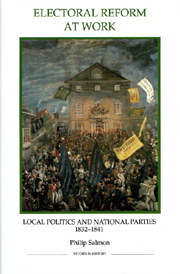Book contents
- Frontmatter
- Contents
- List of illustrations
- List of figures
- List of tables
- Dedication
- Acknowledgements
- Abbreviations
- Introduction
- PART I THE REFORMED ELECTORAL SYSTEM
- 1 Voter registration and the reformed electorate
- 2 Conservative and Liberal electoral organisation
- 3 The election after 1832: tradition and transformation
- PART II THE COUNTIES
- PART III THE BOROUGHS
- Appendices
- Bibliography
- Index
2 - Conservative and Liberal electoral organisation
from PART I - THE REFORMED ELECTORAL SYSTEM
Published online by Cambridge University Press: 12 September 2012
- Frontmatter
- Contents
- List of illustrations
- List of figures
- List of tables
- Dedication
- Acknowledgements
- Abbreviations
- Introduction
- PART I THE REFORMED ELECTORAL SYSTEM
- 1 Voter registration and the reformed electorate
- 2 Conservative and Liberal electoral organisation
- 3 The election after 1832: tradition and transformation
- PART II THE COUNTIES
- PART III THE BOROUGHS
- Appendices
- Bibliography
- Index
Summary
Historians of the nineteenth century have long recognised the role of central election management and constituency organisation in shaping Britain's transition to a modern two-party political system. Considerable confusion, however, surrounds the extent to which the Reform Act triggered new developments in these areas, with obvious implications for any assessment of its long-term political significance. The 1830s, of course, have been traditionally viewed as a ‘golden age’ of club government, in which the pre-Reform political centres of Brooks's and White's were supplanted by an entirely ‘new type’ of central party organisation based around the Carlton and Reform Clubs. But the precise part played by these new London centres in the election and registration campaigns of this period remains unclear. The Carlton, for instance, acquired a formidable reputation for the management of contests, costs and candidates after 1832, not least among Liberal journalists. But to what extent did this image, neatly captured in accounts of its dealings with the young Benjamin Disraeli, reflect the reality? And how comfortably did Sir Robert Peel's extensively cited exhortation to ‘register, register, register!’ fit with the broader attitudes and approaches to electoral management adopted by the leaders of both parties?
The commonly held belief that ‘many aspects of modern party organisation date from the 1830s’ has in recent decades been seriously challenged, most notably by O'Gorman who concluded his account of the unreformed electoral system by arguing that ‘the new party clubs after 1832 were very like the old’ and that ‘even registration was little more than a streamlined means of locating voters’.
- Type
- Chapter
- Information
- Electoral Reform at WorkLocal Politics and National Parties, 1832–1841, pp. 43 - 86Publisher: Boydell & BrewerPrint publication year: 2002



